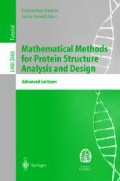Abstract
This article deals with mathematical questions arising from the determination of protein structure from data obtained by solid-state nuclear magnetic resonance (NMR). Solid-state NMR holds the promise of revealing the structure of membrane proteins in a lipid bilayer. The derivation of protein structure from NMR data has most often been done using proteins in liquid state, and the mathematical analysis has been done using distance geometry and distance matrices. The mathematical analysis for solid state NMR uses orientational constraints rather than distance constraints, and matrices of inner products rather than distance matrices. Solving the structure from the data requires supplying a sequence of signs, a situation somewhat analogous to the necessity to supply the phases to solve a structure from x-ray crystallographic data. Other problems in solving for the structure arise from the condition that the gram determinants be non-negative, and this is analogous problem in distance geometry that the distance matrix must satisfy the conditions of the Cayley-Menger theorem.
Access this chapter
Tax calculation will be finalised at checkout
Purchases are for personal use only
Preview
Unable to display preview. Download preview PDF.
References
Cross, T.A., Quine, J.R.: Protein structure in anisotropic environments: development of orientational constraints. Concepts in Magnetic Resonance 12 (2000)
Engh, R.A., Huber, R.: Accurate bond and angle parameters for x–ray protein structure refinement. Acta Crystallogr. A 47, 392–400 (1991)
Havel, T.F., Dress, A.W.M.: Distance geometry and geometric algebra. Foundations of Physics 23, 1357–1374 (1993)
Ketchem, R.R., Lee, K.-C., Huo, S., Cross, T.A.: Macromolecular structural elucidation with solid-state NMR–derived orientational constraints. J. Biomol. NMR 8, 1–14 (1996)
Ketchum, R.R., Roux, B., Cross, T.A.: High-resolution polypeptide structure in a lamellar phase lipid environment from solid state NMR derived orientational constraints. Structure 5, 1655–1669 (1997)
Kvick, A., Al-Karaaghouli, A.R., Koetzle, T.F.: Deformation electron density of α- glycylglycine at 82 K. I. the neutron diffraction study. Acta Crystallogr. B33, 3796–3801 (1977)
Quine, J.R., Cross, T.A.: Protein structure in anisotropic environments: unique structural fold from orientational constraints. Concepts in Magnetic Resonance 12 (2000)
Author information
Authors and Affiliations
Editor information
Editors and Affiliations
Rights and permissions
Copyright information
© 2003 Springer-Verlag Berlin Heidelberg
About this paper
Cite this paper
Quine, J.R., Cross, T.A. (2003). Protein Structure from Solid-State NMR. In: Guerra, C., Istrail, S. (eds) Mathematical Methods for Protein Structure Analysis and Design. Lecture Notes in Computer Science(), vol 2666. Springer, Berlin, Heidelberg. https://doi.org/10.1007/978-3-540-44827-3_9
Download citation
DOI: https://doi.org/10.1007/978-3-540-44827-3_9
Publisher Name: Springer, Berlin, Heidelberg
Print ISBN: 978-3-540-40104-9
Online ISBN: 978-3-540-44827-3
eBook Packages: Springer Book Archive

